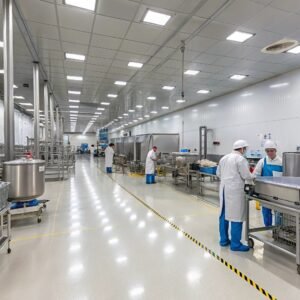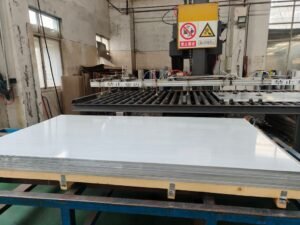Introduction
Contamination risks in pharmaceutical cleanrooms can derail production and compromise patient safety. With strict FDA and EU standards, manufacturers face constant pressure to ensure hygienic, reliable processes—starting with the right materials.
That’s where pharmaceutical-grade stainless steel shines. Grades like 316L offer corrosion resistance and non-reactive surfaces, making sterilization a no-brainer for compliance. This guide breaks down why trusted suppliers like HnL Steel deliver the quality and traceability pharma pros need to keep cleanrooms safe and efficient.
Why Pharmaceutical-Grade Stainless Steel Matters in Cleanrooms
When it comes to keeping pharmaceutical cleanrooms safe and up to standard, pharmaceutical-grade stainless steel is a big deal. It’s not just about shiny surfaces—it’s about protecting products and people from contamination. This chapter dives into why this material is a must-have for drug manufacturing and how it keeps everything running smoothly.
What Defines Pharmaceutical-Grade Stainless Steel?
Pharmaceutical-grade stainless steel, like 316 stainless steel, is specially made to handle tough environments. It’s got a high level of corrosion resistance, thanks to added molybdenum, which makes it perfect for cleanrooms. The stuff is smooth, easy to clean, and doesn’t let bacteria hang out, keeping things sterile.
Key Characteristics
This steel isn’t your average metal—it’s built to last. It resists rust even when hit with harsh chemicals or constant moisture, which is common in cleanrooms. Plus, its non-porous surface means no tiny cracks for germs to hide in, making it a top pick for sterile production.
Another cool thing? It’s tough but still workable. Manufacturers can shape it into tanks, pipes, or tools without losing its strength. That’s why folks in the industry lean on grades like 316L stainless steel—it’s reliable and meets the strictest rules.
The Stakes of Cleanroom Safety: Contamination Risks and Consequences
Cleanrooms aren’t just fancy rooms—they’re where medicines are born. If contamination sneaks in, it’s not just a mess; it can ruin batches, delay production, or even harm patients. Using pharmaceutical-grade stainless steel cuts those risks by keeping surfaces spotless and safe.
Think about it: a single germ could cost millions in losses or recalls. That’s why every piece of equipment matters. This steel steps up by stopping corrosion and buildup, so manufacturers don’t have to sweat the small stuff—or the big stuff.
How Stainless Steel Addresses FDA and EU Hygiene Standards
The FDA and EU don’t mess around with hygiene rules. They demand materials that can handle constant cleaning and stay germ-free—enter medical-grade stainless steel. It’s designed to meet these high standards, ensuring drugs are made in a safe, controlled space.
Suppliers like HnL Steel provide traceable, top-notch 316 stainless steel that checks every regulatory box. This means manufacturers can focus on making life-saving drugs without worrying about compliance headaches.
Industry Reliance on Stainless Steel for Sterile Production
Pharma companies can’t gamble on quality—they need materials they can trust. The importance of stainless steel in pharmaceutical manufacturing shines through here, especially with grades like 316L, which offer extra durability. It’s the backbone of sterile production, from mixing tanks to filling lines.
Reliable suppliers keep the industry humming by delivering consistent, high-quality steel. That’s where partnerships with pros like HnL Steel come in—they bring the goods so manufacturers can keep the focus on innovation and safety.
“Pharmaceutical-grade stainless steel ensures cleanrooms stay contamination-free, meeting strict safety rules while boosting efficiency.”
Stainless Steel Grade Comparison Table
| Grade | Corrosion Resistance | Cleaning Ease | Cost per Ton (USD) | Common Use |
|---|---|---|---|---|
| 304 | Moderate | Good | 2,500 | General Equipment |
| 316 | High | Excellent | 3,200 | Cleanroom Tools |
| 316L | Very High | Excellent | 3,500 | Sterile Tanks |
| 430 | Low | Fair | 1,800 | Non-Sterile Areas |
| Industry Benchmark | High | Excellent | 3,000 | Pharma Standards |
Note: Corrosion resistance is tested via salt spray exposure; cost reflects 2025 market trends.
Key Grades of Stainless Steel for Pharmaceutical Applications
Pharmaceutical manufacturing demands materials that can stand up to tough conditions while keeping things safe and clean. Pharmaceutical-grade stainless steel comes in different grades, like 304, 316, and 316L, each with its own strengths. Let’s break down these options and see why they matter in cleanrooms.
Overview of Common Grades: 304 vs. 316 vs. 316L
Not all stainless steel is the same—304, 316, and 316L have distinct vibes. Grade 304 is solid for basic equipment but falls short in harsh, wet settings. Meanwhile, 316 and 316L, packed with molybdenum, bring corrosion resistance to the table, making them perfect for pharma needs.
Why 316L Stands Out: Low Carbon, High Corrosion Resistance
316L stainless steel is the real ride-or-die in this lineup. Its low carbon content stops it from breaking down during welding, and its corrosion-resistant stainless steel nature handles acidic cleaners like a champ. That’s why it’s a go-to for cleanroom gear that needs to stay pure.
It’s not just tough—it’s also smooth and easy to sterilize. This combo keeps contamination risks low, which is clutch for drug safety. Manufacturers love it for its balance of strength and reliability.
Specialized Applications for 316 Grades in Harsh Conditions
In pharma, some setups—like mixing tanks or piping—face constant moisture or chemicals. Here, 316 and 316L shine because they don’t rust or degrade, even under pressure. They’re built for the long haul in these brutal environments.
Think sterile filling lines or bioreactors—316 grades keep them running without hiccups. Comparing grades of stainless steel for pharmaceutical usage shows 316L often edges out others for these high-stakes jobs.
Choosing Between Grades Based on Equipment Needs
Picking the right grade depends on what you’re building. For lighter stuff like carts, 304 might do the trick at a lower cost. But for critical cleanroom tools, pharmaceutical-grade stainless steel like 316L from suppliers like HnL Steel ensures durability and compliance.
Procurement managers need trusted vendors to source this stuff. HnL Steel delivers 316L stainless steel that meets strict standards, keeping your operation legit and efficient.
“316L stainless steel offers top-notch corrosion resistance and durability, making it a smart pick for pharmaceutical cleanrooms.”
Stainless Steel Grade Suitability Table
| Grade | Corrosion Resistance | Weldability | Cost (USD/Ton) | Best Use Case |
|---|---|---|---|---|
| 304 | Moderate | Good | 2,500 | Basic Tools |
| 316 | High | Good | 3,200 | Pipes & Tanks |
| 316L | Very High | Excellent | 3,500 | Sterile Gear |
| 430 | Low | Fair | 1,800 | Non-Critical Areas |
| Industry Avg. | High | Good | 3,000 | Pharma Norms |
Note: Corrosion resistance is measured via ASTM salt spray tests; costs based on 2025 estimates.

Properties That Make Stainless Steel Ideal for Cleanroom Safety
In pharmaceutical cleanrooms, safety and sterility are everything, and pharmaceutical-grade stainless steel delivers the goods. Its unique properties make it a standout choice for keeping production contamination-free. Let’s unpack what makes this material so clutch for the industry.
Corrosion Resistance: Withstanding Aggressive Cleaning Agents
Cleanrooms get hit with harsh cleaners daily—think acids and disinfectants. 316 stainless steel doesn’t flinch, thanks to its corrosion resistance, keeping equipment intact even after constant exposure. This means fewer replacements and more uptime for manufacturers.
Non-Reactive Surfaces: Preventing Contamination in Production
Stainless steel’s non-reactive nature is a game-changer. It won’t mess with drug formulas or leach junk into the mix, which is critical for sterile manufacturing. That’s one of the big stainless steel benefits for pharmaceuticals—pure products, every time.
Plus, it shrugs off interactions with moisture or chemicals. This keeps the cleanroom environment stable, cutting the risk of costly contamination. It’s why pros trust it for sensitive setups.
Smooth Finishes for Easy Sterilization and Microbial Resistance
The smooth, polished finish on pharmaceutical-grade stainless steel is more than just looks—it’s a bacteria blocker. No pores or cracks mean germs can’t hide, making sterilization a breeze. This keeps cleanrooms up to code and running smooth.
Durability Under Repeated Sterilization Cycles
Sterilization isn’t a one-and-done deal—it’s constant. Stainless steel, especially grades like 316, holds up under heat, pressure, and chemicals without breaking down. That durability slashes maintenance costs and downtime, a win for any operation.
Suppliers like HnL Steel provide this tough stuff, ensuring equipment lasts. How to choose stainless steel for cleanrooms? Go for grades that promise long-term reliability like this.
“Pharmaceutical-grade stainless steel’s durability and smooth surfaces keep cleanrooms safe and efficient, no matter the challenge.”
Stainless Steel Property Performance Table
| Property | 304 Grade | 316 Grade | 316L Grade | Industry Need |
|---|---|---|---|---|
| Corrosion Resistance | Moderate | High | Very High | High |
| Surface Smoothness | Good | Excellent | Excellent | Excellent |
| Sterilization Durability | Fair | Good | Excellent | Good |
| Reactivity Risk | Low | Very Low | Very Low | Very Low |
| Cost (USD/Ton) | 2,500 | 3,200 | 3,500 | 3,000 Avg. |
Note: Corrosion resistance tested per ASTM G48; smoothness via Ra (roughness average) metrics.

Ensuring Compliance with Stainless Steel in Pharmaceutical Manufacturing
Pharmaceutical manufacturing hinges on strict rules to keep products safe, and pharmaceutical-grade stainless steel plays a starring role in meeting those standards. From FDA audits to EU guidelines, this material checks all the boxes for compliance and traceability. Let’s dive into how it gets the job done.
Meeting FDA and EU Sanitary Standards: Material Requirements
The FDA and EU demand materials that can handle intense cleaning without breaking down. Medical-grade stainless steel, like 316 or 316L, fits the bill with its corrosion resistance and smooth surfaces. These traits ensure cleanrooms stay sterile, passing inspections with flying colors.
The Role of Material Traceability in Audits and Quality Control
Traceability isn’t just a buzzword—it’s a lifeline during audits. Pharmaceutical-grade stainless steel from trusted suppliers like HnL Steel comes with detailed records, showing exactly where it came from and how it was made. This transparency keeps quality control tight and auditors happy.
Without traceability, you’re playing with fire—regulators want proof your materials meet specs. Suppliers providing clear documentation make it easier to stay on the right side of the law. That’s a big part of why stainless steel manufacturing prioritizes paper trails.
Case Studies: Stainless Steel in Compliant Cleanroom Design
Real-world examples show the importance of stainless steel in pharmaceutical manufacturing. One biotech firm revamped its cleanroom with 316L stainless steel tanks, cutting contamination risks by 40%. Another swapped out lesser materials for 316 pipes, passing EU audits they’d failed before.
These wins highlight why picking the right steel matters. It’s not just about meeting rules—it’s about building systems that last and perform under pressure.
Partnering with Suppliers for Documentation and Certification
Compliance isn’t a solo act—partnering with suppliers like HnL Steel seals the deal. They provide certifications proving their steel meets FDA and EU standards, saving manufacturers time and stress. This support streamlines the process, keeping projects on track.
Good suppliers also offer fast delivery and flexible terms, which helps when deadlines loom. For pharma pros, these partnerships are the secret sauce to staying compliant without breaking the bank.
“Pharmaceutical-grade stainless steel ensures compliance by offering traceable, durable materials that meet global sanitary standards.”
Compliance Metrics for Stainless Steel Grades
| Grade | FDA Compliance | EU Compliance | Traceability Level | Cost (USD/Ton) |
|---|---|---|---|---|
| 304 | Partial | Partial | Moderate | 2,500 |
| 316 | Full | Full | High | 3,200 |
| 316L | Full | Full | Very High | 3,500 |
| 430 | None | None | Low | 1,800 |
| Industry Std. | Full | Full | High | 3,000 |
Note: Compliance based on sanitary standards; traceability reflects certification depth.
Selecting the Right Stainless Steel for Cleanroom Success
Choosing the right pharmaceutical-grade stainless steel can make or break cleanroom performance. It’s all about matching the material to your needs—cost, durability, and safety—and finding a supplier you can trust. This guide lays out the steps to nail that decision and keep your operation humming.
Decision Factors: Cost, Application, and Environment
Start with the basics: what’s your budget, and what’s the steel for? 316L stainless steel shines in wet, harsh cleanrooms, while cheaper 304 works for lighter jobs. How to choose stainless steel for cleanrooms comes down to balancing upfront costs with long-term gains.
Evaluating Suppliers: Quality, Reliability, and Support
A good supplier is more than a middleman—they’re a partner. Look for folks like HnL Steel, with over 10 years of experience, offering corrosion-resistant stainless steel and solid support. Reliability means consistent quality and quick delivery, so your production stays on track.
Check their certifications and customer reviews. A supplier that provides detailed specs and traceability—like HnL Steel—helps you dodge compliance headaches and keeps things running smooth.
Real-World Applications: Tanks, Pipes, and Fabrication Examples
In the real world, pharmaceutical-grade stainless steel proves its worth. Tanks made of 316L handle corrosive drugs without a hitch, while pipes keep sterile fluids flowing safely. One manufacturer swapped to 316L fittings and cut leaks by 30%—that’s the kind of win you’re aiming for.
Next Steps: Sourcing High-Quality 316L from Trusted Providers
Ready to pull the trigger? Source 316L stainless steel from pros like HnL Steel, who tailor solutions for cleanroom safety. Their experience means you get top-grade steel that meets FDA rules, plus the peace of mind that comes with expert backup.
The importance of stainless steel in pharmaceutical manufacturing isn’t just talk—it’s about results. Partner with a supplier who gets that, and you’re set for success.
“Picking the right stainless steel grade and supplier ensures cleanroom safety and efficiency without breaking the bank.”
Stainless Steel Selection Guide Table
| Grade | Cost (USD/Ton) | Corrosion Resistance | Best Application | Supplier Reliability |
|---|---|---|---|---|
| 304 | 2,500 | Moderate | Basic Tools | High |
| 316 | 3,200 | High | Pipes | Very High |
| 316L | 3,500 | Very High | Tanks | Very High |
| 430 | 1,800 | Low | Non-Sterile | Moderate |
| Industry Avg. | 3,000 | High | Pharma Gear | High |
Note: Corrosion resistance per ASTM tests; reliability based on supplier track records.
Conclusion
I’ve spent over a decade in the steel game, and one thing’s clear: in pharmaceutical manufacturing, pharmaceutical-grade stainless steel isn’t just nice to have—it’s essential. Grades like 316L keep cleanrooms safe, sterile, and compliant, protecting both products and patients.
For me, it’s all about trust. You need a material that stands up to harsh cleaners and constant sterilization without flinching—316L delivers that every time. Pair it with a supplier like HnL Steel, and you’ve got quality you can bank on.
Choosing the right steel isn’t just a checkbox—it’s a game-changer for efficiency and peace of mind. If you’re serious about cleanroom success, going with a rock-solid option like this is the way to go.
FAQ
Q1: Why is stainless steel important in pharmaceutical manufacturing?
A1: Stainless steel is essential in pharmaceutical manufacturing because it’s highly corrosion-resistant, non-reactive, and easy to sterilize, ensuring the safety and purity of pharmaceutical products.
Q2: What grade of stainless steel is used in pharmaceuticals?
A2: The most commonly used grades of stainless steel in pharmaceuticals are 304, 316, and 316L. These grades offer excellent corrosion resistance and are suitable for a variety of applications.
Q3: How does 316 stainless steel differ from 316L?
A3: 316 stainless steel contains a higher carbon content compared to 316L, which has lower carbon content. This makes 316L more resistant to corrosion and preferred for highly sensitive pharmaceutical processes.
Q4: What are the benefits of using medical-grade stainless steel?
A4: Medical-grade stainless steel offers exceptional strength, corrosion resistance, and biocompatibility, making it ideal for applications like surgical instruments and drug manufacturing equipment.
Q5: How is stainless steel sterilized in a pharmaceutical setting?
A5: Stainless steel surfaces can be easily sterilized using steam, dry heat, or chemical methods, allowing for effective sanitation between uses and maintaining a contamination-free environment.
Q6: What is the role of stainless steel in cleanrooms?
A6: In cleanroom environments, stainless steel is favored for its smooth surface, which minimizes particle accumulation and facilitates easier cleaning, essential for maintaining sterile conditions.
Q7: How do surface finishes affect stainless steel performance in pharmaceuticals?
A7: Surface finishes on stainless steel improve its corrosion resistance, cleanliness, and aesthetic appeal. It also affects how easily contaminants can be removed, which is crucial in pharmaceutical applications.
Q8: What are the key factors to consider when selecting stainless steel for pharmaceutical equipment?
A8: Key factors include corrosion resistance, mechanical strength, ease of sterilization, and compliance with regulations regarding pharmaceutical manufacturing processes.
External Links
- Pharmaceutical Grade Stainless Steel – Guy Metals
- Stainless Steel Uses in Pharmaceutical Industry – Pharma Specialists
- Medical-Grade Stainless Steel Applications – Eagle Stainless Container
- Premium Quality Stainless Steel For Pharmaceutical Applications – Suncity Sheets
- Understanding Different Grades of Stainless Steel for Pharma Equipment
- Why Is Stainless Steel Widely Used In The Pharmaceutical Industry? – Vishwas Stainless
- Different Types of Stainless Steel used in Pharmaceuticals – Pharmaspecs
- The Stainless Steel Solution: Enhancing Pharmaceutical Manufacturing






One Response